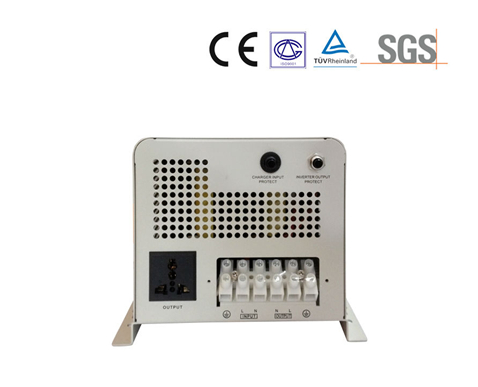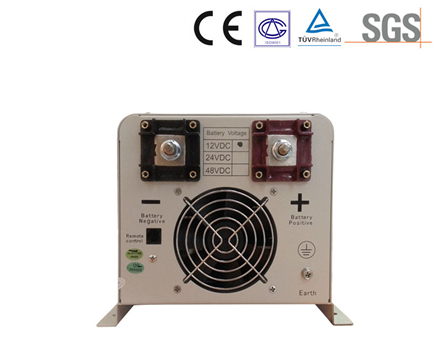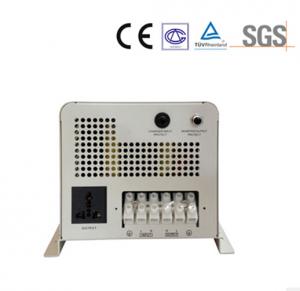Solar Inverter, 3.5kva 24V High Quality/Reasonable Price pure Sine Wave Solar Inverter
- Loading Port:
- Shanghai
- Payment Terms:
- TT or LC
- Min Order Qty:
- 400000 watt
- Supply Capability:
- 3000000 watt/month
OKorder Service Pledge
OKorder Financial Service
You Might Also Like
1. Structure of Solar Inverter, 3.5kva 24V High Quality/Reasonable Price pure Sine Wave Solar Inverter Description
The inverter series is an electronic product that has been designed and built to take low DC woltage power from batteries and convert it to
standard AC power like the current you have at home.
The Inverter series is a DC-to-AC with auto line-to-battery transfer and intergrated charging system. Inverter series powers from ACpower
and DC source, serving as an extended run UPS. When AC cable is connected to a wall socket, utility power goes to connected equipment
and/or charges the battery set via charging system. In Inverter mode, the Inverter series automatically converts battery energy into AC power
for backing up the connected devices.
2. Main Features of Solar Inverter, 3.5kva 24V High Quality/Reasonable Price pure Sine Wave Solar Inverter
• Super efficient, DC to AC conversion, minimizing charging losses
• Input Voltage rangeselect
• 5kva pure sine wave solar inverter
3. Solar Inverter, 3.5kva 24V High Quality/Reasonable Price pure Sine Wave Solar Inverter Images


4. Solar Inverter, 3.5kva 24V High Quality/Reasonable Price pure Sine Wave Solar Inverter Specification
Model | FL-IVP3524-3500VA |
Rated output power | 3500VA |
Max charge current | 35A |
Normal DC input voltage | 24V |
Nominal input power | 110Vac/120Vac/220Vac/230Vac |
Input voltage range | 96~132Vac/155~272Vac |
Charge current regulation | Charge current adjustable:25%,50%,75%,100%(Optional) |
Normal output frequency | 60Hz/50Hz |
Over load protection(SMPS) | Circuit breaker |
Output short circuit protection | Circuit breaker |
Efficiency | >95% |
Output voltage waveform | Pure sine wave |
5. FAQ of Solar Inverter, 3.5kva 24V High Quality/Reasonable Price pure Sine Wave Solar Inverter
Q1:Can we visit your factory?
A1:Sure,welcome at any time,seeing is believing.
Q2:Which payment terms can you accept?
A2:T/T,L/C,Moneygram,Paypal are available for us.
- Q:Can a solar inverter be used with a solar-powered backup generator?
- Yes, a solar inverter can be used with a solar-powered backup generator. The solar inverter is responsible for converting the direct current (DC) generated by the solar panels into alternating current (AC) that can be used to power household appliances and electrical devices. When connected to a solar-powered backup generator, the solar inverter can efficiently regulate and distribute the electricity produced by the generator, providing a reliable and sustainable source of power.
- Q:How does the power factor correction affect the performance of a solar inverter?
- Power factor correction can greatly improve the performance of a solar inverter by ensuring that the power drawn from the grid is utilized efficiently. By correcting the power factor, the inverter reduces the reactive power component and increases the power factor closer to unity. This reduction in reactive power results in a more efficient utilization of the available power, leading to increased energy conversion efficiency and reduced losses in the inverter. Additionally, power factor correction helps in complying with grid regulations and prevents penalties or restrictions imposed by utility companies.
- Q:How does a solar inverter synchronize with the grid frequency?
- A solar inverter synchronizes with the grid frequency by continuously monitoring the frequency of the electrical power supplied by the grid. It adjusts its own output frequency to match the grid frequency using a built-in control mechanism. This synchronization ensures that the solar inverter's power is in phase with the grid power, allowing it to smoothly inject electricity into the grid without causing disruptions or power quality issues.
- Q:Can a solar inverter be used with a solar-powered air purification system?
- Yes, a solar inverter can be used with a solar-powered air purification system. A solar inverter is responsible for converting the direct current (DC) produced by solar panels into usable alternating current (AC) for powering electrical devices. In the case of a solar-powered air purification system, the solar inverter would convert the DC power generated by the solar panels into AC power that can be used to run the air purification system. This allows for the system to operate efficiently using clean and renewable solar energy.
- Q:How does a solar inverter protect against overvoltage?
- A solar inverter protects against overvoltage by monitoring the voltage levels of the solar panels. When the voltage exceeds the safe operating range, the inverter automatically reduces the power output or completely shuts down to prevent any damage to the electrical system. Additionally, some inverters are equipped with surge protection devices to further safeguard against sudden voltage spikes.
- Q:Can a solar inverter be used in a net metering system?
- Yes, a solar inverter can be used in a net metering system. A solar inverter is an essential component of a solar energy system, as it converts the direct current (DC) electricity generated by solar panels into alternating current (AC) electricity that can be used to power homes and businesses. In a net metering system, excess electricity generated by the solar panels is fed back into the grid, and a solar inverter facilitates this process by synchronizing the electricity produced with the utility grid.
- Q:How does a solar inverter handle reactive power?
- A solar inverter handles reactive power by implementing power factor correction technology. It actively measures the power factor of the system and adjusts the reactive power to ensure optimal performance and efficient energy conversion. This helps in maintaining a balanced and stable grid connection while minimizing power losses.
- Q:Can a solar inverter be used with different types of power factor correction devices?
- Yes, a solar inverter can be used with different types of power factor correction devices. The solar inverter is responsible for converting the DC power generated by the solar panels into AC power that can be used in homes and businesses. Power factor correction devices, on the other hand, are used to improve the power factor of the electrical system by reducing reactive power. The solar inverter can work in conjunction with various types of power factor correction devices, such as capacitors or active power factor correction units, to optimize the efficiency and performance of the electrical system.
- Q:How does a hybrid solar inverter work?
- A hybrid solar inverter works by converting the direct current (DC) power generated by solar panels into alternating current (AC) power that can be used to power household appliances or be fed back into the grid. It also has the capability to store excess energy in batteries for later use during periods of low solar generation or power outages. This allows for efficient utilization of solar energy and provides backup power when needed.
- Q:What is the maximum number of solar panels that can be connected to a single inverter?
- The maximum number of solar panels that can be connected to a single inverter depends on the specifications and capacity of the inverter. However, there is no fixed number as it varies depending on factors such as the size and wattage of the panels, the voltage and capacity of the inverter, and the overall system design. It is recommended to consult the manufacturer's guidelines or a professional installer to determine the maximum number of panels that can be connected to a specific inverter.
1. Manufacturer Overview |
|
|---|---|
| Location | |
| Year Established | |
| Annual Output Value | |
| Main Markets | |
| Company Certifications | |
2. Manufacturer Certificates |
|
|---|---|
| a) Certification Name | |
| Range | |
| Reference | |
| Validity Period | |
3. Manufacturer Capability |
|
|---|---|
| a)Trade Capacity | |
| Nearest Port | |
| Export Percentage | |
| No.of Employees in Trade Department | |
| Language Spoken: | |
| b)Factory Information | |
| Factory Size: | |
| No. of Production Lines | |
| Contract Manufacturing | |
| Product Price Range | |
Send your message to us
Solar Inverter, 3.5kva 24V High Quality/Reasonable Price pure Sine Wave Solar Inverter
- Loading Port:
- Shanghai
- Payment Terms:
- TT or LC
- Min Order Qty:
- 400000 watt
- Supply Capability:
- 3000000 watt/month
OKorder Service Pledge
OKorder Financial Service
Similar products
New products
Hot products
Hot Searches
Related keywords





























